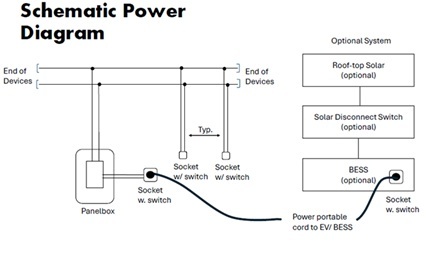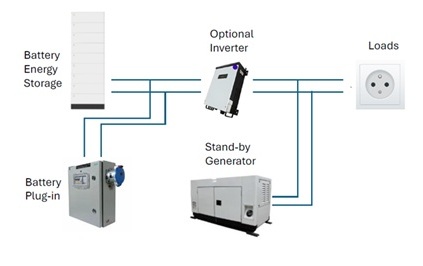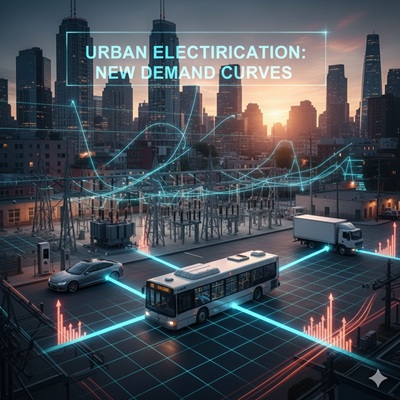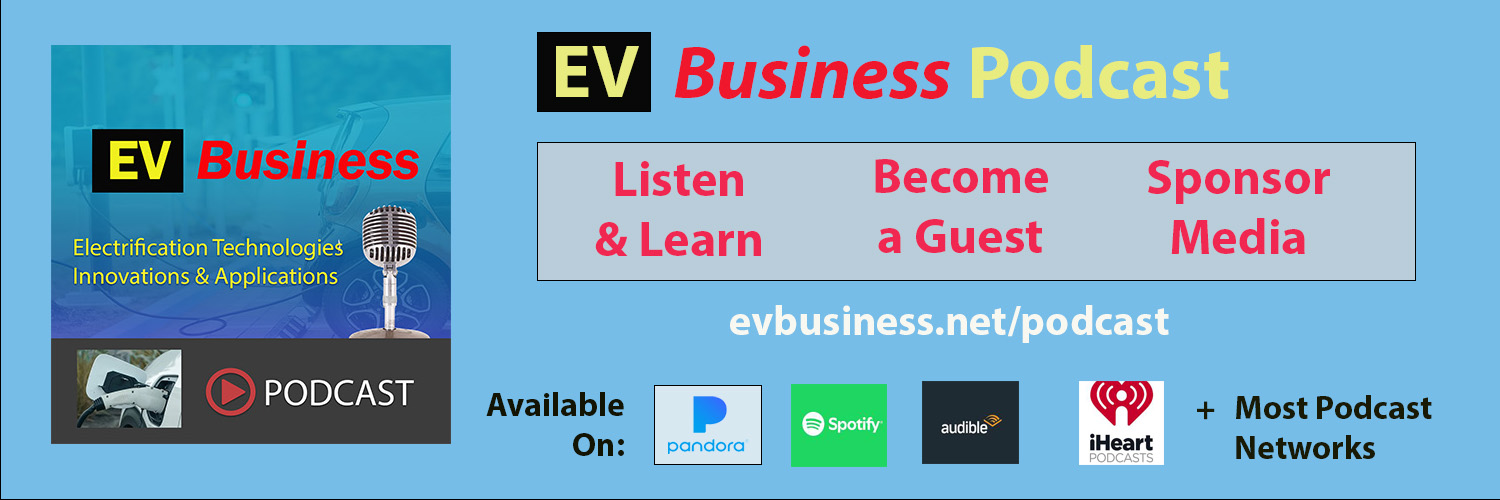By: Dr (hon.) Pravin Sankhwar, PE, LEED AP (BD+C)
As large-scale adoption of electric vehicles progresses at both residential and commercial levels, their charging infrastructure comes as an additional burden on the power grid, not only from their electrical load but also increased challenges with intermittency of grid loading. As millions of drivers transition to EVs, the cumulative effect of charging will place an unprecedented burden on electrical systems, requiring a fundamental shift in how we manage and distribute power. A study by the National Renewable Energy Laboratory (NREL) found that unmanaged charging could lead to a 15% increase in distribution system investment costs and a 40% rise in off-peak network line resistive losses [https://www.osti.gov/servlets/purl/1871657]. These new demands expose several challenges, including the risk of transformer overloads, voltage instability, and increased grid congestion, particularly during peak hours. Without action, the grid risks inefficiency, outages, and rising costs for both suppliers and consumers. This article explores practical strategies—ranging from smart charging management and vehicle-to-grid integration to DC system innovations—that help stabilize power systems, reduce costs, and unlock new opportunities from large-scale electrification.
The term “electrification” means converting the modern transportation systems with electricity as the primary source for propulsion. Railroad systems have commonly used direct current (DC) traction motors and electricity drawn live from overhead catenary wires or ground third rail whereas the existing roadway public transportation systems tend to have challenges with catenary wires to operate safely in densely populated areas. For example, the tram cars electrical system can cause complexity from safety hazards especially from its meshed structure.
The high energy density batteries along with electric motors have allowed the manufacturers to successfully commercialize electric vehicles. Although advanced control systems implementing machine learning and artificial intelligence have strengthened the uptake of electric vehicles amongst broader audiences, the cost of such technology continues to become a limiting factor for many. Researchers continue to explore the options to reduce the cost of the technology by exploring cheaper materials and chemistry for battery packs. For example, solid-state batteries characterized by their faster charging, greater safety, high energy density, and cost effectiveness are ready to be commercialized in 2027 by major automakers such as Toyota. Several proponents of climate change actively support the large-scale electrification of the transportation system. However, industry experts see some challenges with electrification of the roadway transportation system from a grid integration standpoint.
How Electric Vehicles (EVs) Charge
In North America, electric vehicles (EVs) require charging from an external power source rated between 120V to 480V, and equipment capable of either AC slow or DC fast charging. The AC slow charging uses 120V or 240V input power to supply it to the EV via a connector (usually SAE J1772 for most commercial vehicles) without conversion of voltage from AC to DC. However, the DC fast charging is capable of using either 208V or 480V power to charge EV via a connector (usually CHAdeMO, CCS1, or NACS J3400) by converting AC to DC. Charging the battery at DC power significantly reduces the charging session time.
How Does the Power Grid Behave with EV Charging?
For experts in power systems, EV charger is yet another load that comes with its own challenges with integration to the power grid. Typically, demand curves for a given area follow certain fixed patterns such as rising demand from morning 6 am until 5-6pm, where 5-6pm it sees the peak demand, whereas it starts to dip until midnight at slower rates but much faster between midnight to 6am. EV DC fast charging may result in spikes in the demand due to their intermittency. For most users DC fast charging is a viable solution given it saves time. Power system experts have learnt from historic demand curves along with demand response to meet the energy demand on a real time basis. However, EV charging loads bring an overall increased demand no matter whether it’s at an elongated six-to-eight-hour period from AC slow charging or 20 to 60 minutes from DC fast charging. AC slow charging reduces the extent of contribution towards the peak demand because of lower power rating (2.5 to 22kW) compared to DC charging (30kW to 350kW or higher).
Bi-Directional Power Opportunities with Electric Vehicles
EVs come with a vast potential of storage systems from the inherent battery packs. For example, an electrified fleet for a major transportation company parked in their facility overnight becomes a huge storage system. Therefore, a Vehicle-2-Grid (V2G) system can successfully harness the stored energy and return to the grid allowing a bi-directional power flow. Grid integrated battery energy storage systems are not uncommon practice especially when large-scale utility scale solar and wind farms are known to operate within such scenarios. The distributed nature of the battery storage from EVs causes challenges with grid integration.
Demand Curve Optimization & Boost Generation
Figure 1 proposes three solutions to optimize the demand curve and boost the generation. This demand curve characterizes mainly residential and commercial facilities. Utility companies publish specific demand curves depicting electric demand (kW) based on the time of the day.

Figure 1. Demand Curve and Proposed Solutions
- Using the region of low demand portion between mid-night to early mornings as preferred time to charge the EVs. This is possible with either home charging or overnight charging the fleet vehicles. These vehicles may return to work later during the day.
- Boosting the generation from roof-top solar photovoltaic systems in conjunction with battery energy storage systems (BESS) for residential and commercial users helps reduce the dependence on grids to add new generation plants. This will support in increasing overall available capacity of generation and enrich low carbon emission systems.
- Using battery energy storage systems (BESS) and energy management systems (EMS) for commercial fast charging helps with shaving the peak demand. This concept involves installing EV charging hubs with large BESS’s that are capable of discharging power to EVs but inherently doesn’t add demand during peak demand. For example, BESS charge during off-peak duration and discharge during any instance of intermittent EV charging. This potentially reduces the intermittent demand addition but increases the cost of installation of BESS and EMS.
Opportunities with DC Power Systems
Given the batteries operate at DC voltages and power generation from renewable energy is DC itself, a vast potential is available from operating power distribution systems at DC. This concept begins with DC power generation from renewable energy then DC transmission & distribution and finally supplying DC voltages directly to the EVs. Although such as system requires significant changes by using HVDC lines, DC-DC converters, and charging infrastructure customized to operate with supply DC voltages, its advantages in reducing system complexities can outweigh the costs. A simple DC power system at residential and commercial facility has been demonstrated which runs off-grid as shown below in Figure 2 & 3. Such DC power systems can reduce the multiple stages of conversion from rectification (AC to DC) & inversion (DC to AC). Also, it can allow many connected residential homes to run on small DC power systems operating with roof-top solar to power their community loads while completely staying off-the-grid either during peak demand or while intending to reduce the overall burden on the grid.

Figure 2. DC System with Plug-in Point, & Roof-top Solar

Figure 3. DC System with Plug-in Point, BESS, & Standby Generator
Emerging technologies in batteries, electric motors, artificial intelligence, and grid integrated (V-2-G) systems let the large-scale adoption of EVs become commercially feasible. System inefficiencies from operating charging infrastructure at both AC and DC for EV charging infrastructure can be minimized by adopting DC systems. Small integrated residential homes with roof-top solar, BESS, EMS, and EVs drive a solution to both increasing energy demand and reducing dependence on fossil fuels.

About Dr. (hon.) Pravin Sankhwar, PE, LEED AP (BD+C)
Pravin Sankhwar is leading expert and licensed professional engineer in electrical engineering with focus on power systems. He holds both BS and MS degrees in Electrical Engineering and distinguished professional achievements. His research interests include electrification, renewable energy, power distribution systems, energy efficient systems, and many more. Having conferred an honorary doctorate and lifetime achievement awards, Pravin’s impact has benefited the power industry. He aims at educating the communities on electrification of transportation systems through his engagement in volunteer activities with professional societies.


